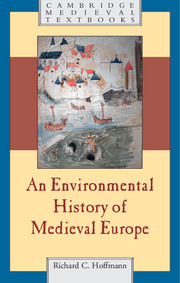Book contents
- Frontmatter
- Contents
- List of figures
- List of maps
- Preface
- Frontispiece: Nature and culture at Waterford, Ireland, 1372
- Introduction: Thinking about medieval Europeans in their natural world
- 1 Long no wilderness
- 2 Intersecting instabilities: culture and nature at medieval beginnings, c.400–900
- 3 Humankind and God’s Creation in medieval minds
- 4 Medieval land use and the formation of traditional European landscapes
- 5 Medieval use, management, and sustainability of local ecosystems, 1: primary biological production sectors
- 6 Medieval Use, management, and sustainability of local ecosystems, 2: interactions with the non-living environment
- 7 ‘This belongs to me . . .’
- 8 Suffering the uncomprehended: disease as a natural agent
- 9 An inconstant planet, seen and unseen, under foot and overhead
- 10 A slow end of medieval environmental relations
- Afterword
- A sampler for further reading
- Index
8 - Suffering the uncomprehended: disease as a natural agent
Published online by Cambridge University Press: 05 July 2014
- Frontmatter
- Contents
- List of figures
- List of maps
- Preface
- Frontispiece: Nature and culture at Waterford, Ireland, 1372
- Introduction: Thinking about medieval Europeans in their natural world
- 1 Long no wilderness
- 2 Intersecting instabilities: culture and nature at medieval beginnings, c.400–900
- 3 Humankind and God’s Creation in medieval minds
- 4 Medieval land use and the formation of traditional European landscapes
- 5 Medieval use, management, and sustainability of local ecosystems, 1: primary biological production sectors
- 6 Medieval Use, management, and sustainability of local ecosystems, 2: interactions with the non-living environment
- 7 ‘This belongs to me . . .’
- 8 Suffering the uncomprehended: disease as a natural agent
- 9 An inconstant planet, seen and unseen, under foot and overhead
- 10 A slow end of medieval environmental relations
- Afterword
- A sampler for further reading
- Index
Summary
Successive chapters have traced the interplay in medieval Europe between natural conditions that called for human adaptation and technological development on the one side and the environmental consequences of such cultural changes as landscape creation, cerealization, energy technologies, and urbanization on the other. But the interaction between human culture and the natural sphere has two dynamic elements, not just one: the natural sphere is always an autonomous actor, capable of initiating and altering human environmental relations, not merely part of the scenery or something that responds to whatever humans do. This chapter and the next show what natural forces and phenomena at both the smallest biological and largest planetary scales did in the Middle Ages. Microscopic pathogens of which medieval Europeans had barely an inkling afflicted, shaped, and ended human lives.
Medieval European history is punctuated by acute and large-scale epidemic events which transpired against a shifting background of long-term endemic diseases. These experiences, both the epidemics and the patterns of endemic disease, resulted in a history of microbiological environments in medieval Europe. Parasites generated a history because the effects of biological processes on individual human bodies and society in general resonated in popular as well as learned thinking. The experience of a disease as represented in medieval culture led to programmes with material consequences arising from people trying to handle their situation. Much of what follows contrasts the present-day observer’s knowledge, riddled with historical lacunae, with the understandings of contemporaries who could observe, however acutely, only superficial symptoms of what was happening to them and struggled in vain to understand, much less to manipulate, those natural forces.
- Type
- Chapter
- Information
- An Environmental History of Medieval Europe , pp. 279 - 303Publisher: Cambridge University PressPrint publication year: 2014

